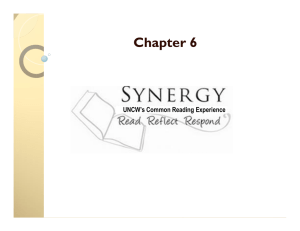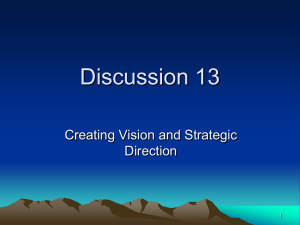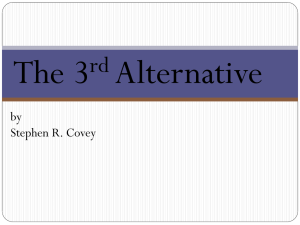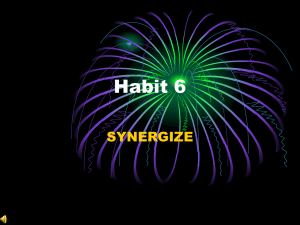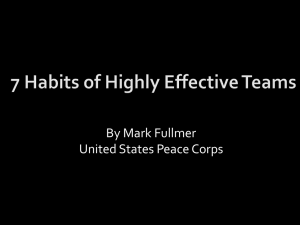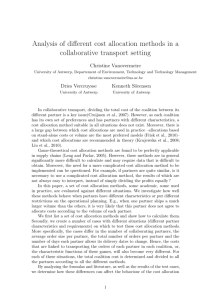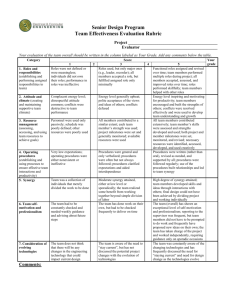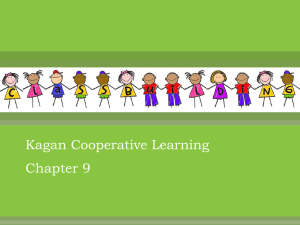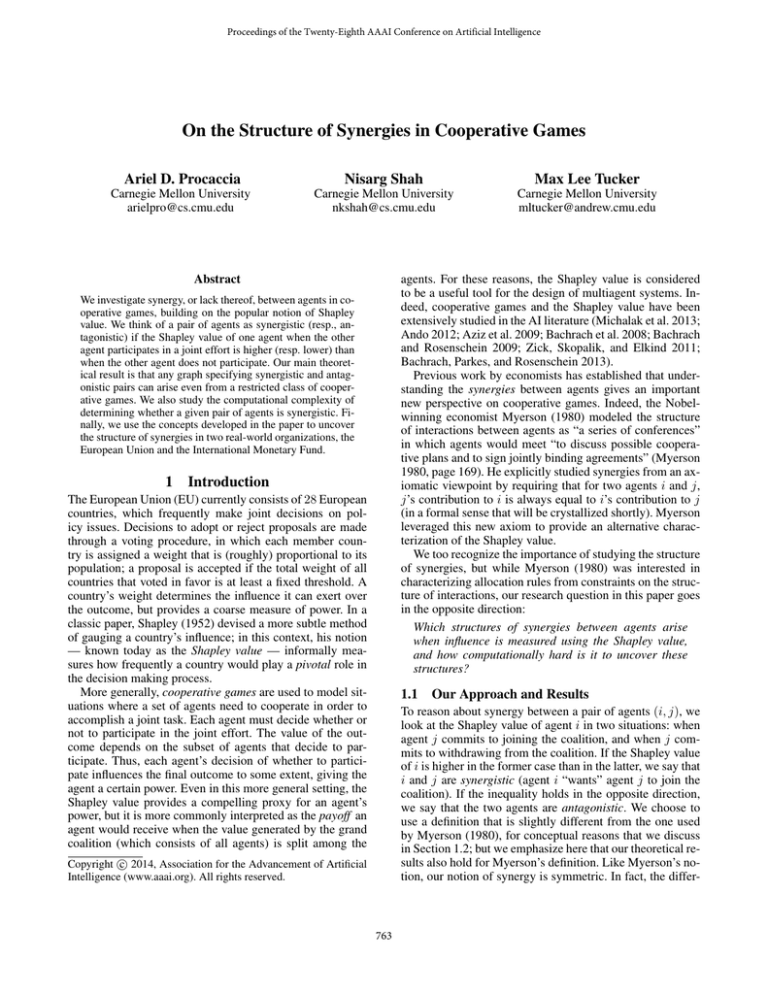
Proceedings of the Twenty-Eighth AAAI Conference on Artificial Intelligence
On the Structure of Synergies in Cooperative Games
Ariel D. Procaccia
Nisarg Shah
Max Lee Tucker
Carnegie Mellon University
arielpro@cs.cmu.edu
Carnegie Mellon University
nkshah@cs.cmu.edu
Carnegie Mellon University
mltucker@andrew.cmu.edu
Abstract
agents. For these reasons, the Shapley value is considered
to be a useful tool for the design of multiagent systems. Indeed, cooperative games and the Shapley value have been
extensively studied in the AI literature (Michalak et al. 2013;
Ando 2012; Aziz et al. 2009; Bachrach et al. 2008; Bachrach
and Rosenschein 2009; Zick, Skopalik, and Elkind 2011;
Bachrach, Parkes, and Rosenschein 2013).
Previous work by economists has established that understanding the synergies between agents gives an important
new perspective on cooperative games. Indeed, the Nobelwinning economist Myerson (1980) modeled the structure
of interactions between agents as “a series of conferences”
in which agents would meet “to discuss possible cooperative plans and to sign jointly binding agreements” (Myerson
1980, page 169). He explicitly studied synergies from an axiomatic viewpoint by requiring that for two agents i and j,
j’s contribution to i is always equal to i’s contribution to j
(in a formal sense that will be crystallized shortly). Myerson
leveraged this new axiom to provide an alternative characterization of the Shapley value.
We too recognize the importance of studying the structure
of synergies, but while Myerson (1980) was interested in
characterizing allocation rules from constraints on the structure of interactions, our research question in this paper goes
in the opposite direction:
Which structures of synergies between agents arise
when influence is measured using the Shapley value,
and how computationally hard is it to uncover these
structures?
We investigate synergy, or lack thereof, between agents in cooperative games, building on the popular notion of Shapley
value. We think of a pair of agents as synergistic (resp., antagonistic) if the Shapley value of one agent when the other
agent participates in a joint effort is higher (resp. lower) than
when the other agent does not participate. Our main theoretical result is that any graph specifying synergistic and antagonistic pairs can arise even from a restricted class of cooperative games. We also study the computational complexity of
determining whether a given pair of agents is synergistic. Finally, we use the concepts developed in the paper to uncover
the structure of synergies in two real-world organizations, the
European Union and the International Monetary Fund.
1
Introduction
The European Union (EU) currently consists of 28 European
countries, which frequently make joint decisions on policy issues. Decisions to adopt or reject proposals are made
through a voting procedure, in which each member country is assigned a weight that is (roughly) proportional to its
population; a proposal is accepted if the total weight of all
countries that voted in favor is at least a fixed threshold. A
country’s weight determines the influence it can exert over
the outcome, but provides a coarse measure of power. In a
classic paper, Shapley (1952) devised a more subtle method
of gauging a country’s influence; in this context, his notion
— known today as the Shapley value — informally measures how frequently a country would play a pivotal role in
the decision making process.
More generally, cooperative games are used to model situations where a set of agents need to cooperate in order to
accomplish a joint task. Each agent must decide whether or
not to participate in the joint effort. The value of the outcome depends on the subset of agents that decide to participate. Thus, each agent’s decision of whether to participate influences the final outcome to some extent, giving the
agent a certain power. Even in this more general setting, the
Shapley value provides a compelling proxy for an agent’s
power, but it is more commonly interpreted as the payoff an
agent would receive when the value generated by the grand
coalition (which consists of all agents) is split among the
1.1
Our Approach and Results
To reason about synergy between a pair of agents (i, j), we
look at the Shapley value of agent i in two situations: when
agent j commits to joining the coalition, and when j commits to withdrawing from the coalition. If the Shapley value
of i is higher in the former case than in the latter, we say that
i and j are synergistic (agent i “wants” agent j to join the
coalition). If the inequality holds in the opposite direction,
we say that the two agents are antagonistic. We choose to
use a definition that is slightly different from the one used
by Myerson (1980), for conceptual reasons that we discuss
in Section 1.2; but we emphasize here that our theoretical results also hold for Myerson’s definition. Like Myerson’s notion, our notion of synergy is symmetric. In fact, the differ-
c 2014, Association for the Advancement of Artificial
Copyright Intelligence (www.aaai.org). All rights reserved.
763
pairs of agents are used to define the game. Conitzer and
Sandholm (2006) extended this approach to a more general
synergy-based representation. Both papers focus on using
given synergies to represent a cooperative game, and study
the computational complexity of various cooperative solution concepts in terms of this game representation.
A number of recent publications in the AI literature (Voice, Ramchurn, and Jennings 2012; Bistaffa et al.
2014; Vinyals et al. 2013) have used the term “synergy
graph” to denote a communication graph that shows connections between agents; its connected subgraphs are the
feasible coalitions. In these papers, the feasible coalitions
can then be assigned any real value. In contrast, the synergy
graph in our work measures synergies between agents based
on the actual values of coalitions.
ence between the Shapley values in the two scenarios mentioned above is invariant to switching the roles of i and j.
To set up our main theoretical result, we define a synergy
graph — a complete undirected graph where the vertices
are agents and each edge is labeled as synergistic or antagonistic. We show that any synergy graph can arise from a
strictly monotonic cooperative game. This result implies that
the question of whether a pair of agents is synergistic or antagonistic is, in a sense, independent of the relationships between other pairs, thereby giving rise to a rich set of possible
synergy structures.
Our second theoretical result asserts that it is computationally hard to check if a given pair of agents is synergistic
or antagonistic, even in weighted voting games (WVGs) —
perhaps the most popular of all cooperative games.
Finally, we complement our theoretical results with experiments dealing with two real-world WVGs: decision making
in the European Union (EU) and in the International Monetary Fund (IMF). We identify surprising structures among
synergistic and antagonistic pairs in these domains.
1.2
2
Preliminaries
A transferable utility cooperative game (hereinafter simply
referred to as a game) G = (N, v) is composed of a set of
agents N = {1, 2, . . . , n} (also called the grand coalition)
and a characteristic function v : 2N → R+ ∪ {0} mapping any coalition (agent subset) to the utility these agents
achieve together. For an agent i ∈ N and a coalition S ⊆ N ,
we denote S ∪ {i} by S + i and S \ {i} by S − i.
A game is called simple if the characteristic function only
takes values in {0, 1}. A game is called monotonic (resp.
strictly monotonic) if larger coalitions have greater value,
i.e., for S ( T ⊆ N , v(S) ≤ v(T ) (resp. v(S) < v(T )).
Related Work
Myerson’s (1980) seminal paper initiated a line of influential work building on his axiom of balanced contributions (i.e., the synergy relation is symmetric) to characterize the Shapley value or extensions thereof, such as
the Owen value (Owen 1977); see, e.g., the work of Hart
and Mas (1989), Calvo et al. (1996), and Grabisch and
Roubens (1999). Myerson’s notion of synergy is slightly different from the one we employ: he considers the difference
between the Shapley value of agent i when agent j has not
made any commitments, and the Shapley value of agent i
when agent j commits to withdrawing from the coalition (we
replace the former term with the Shapley value of i when j
commits to joining). A disadvantage of Myerson’s definition is that it depends on a comparison of the Shapley values
of an agent in two games with different numbers of agents.
In some games the Shapley value is inherently biased to be
higher in the game with a smaller number of agents, making
the comparison of the difference to zero biased. For example, Myerson’s definition characterizes almost all pairs of
agents in the European Union (EU) and in the International
Monetary Fund (IMF) as antagonistic. That said, the theoretical differences between the two notions are minor, and (as
noted above) our theoretical results hold for both definitions.
The first attempt to define and quantify synergy dates further back to Owen (1972), whose idea was then rediscovered
by Murofushi and Soneda (1993) in the field of fuzzy control
systems. Their measure, known as the interaction index, calculates the synergistic interaction between two agents by accounting for the surplus generated by their cooperation in all
possible coalitions, in a manner similar to ours. Later, Grabisch and Roubens (1999) extended this definition to synergy among more than two agents. These papers have given
rise to a body of literature on measuring synergy in fuzzy
systems and related fields.
Synergies in cooperative games have also been studied by
CS and AI researchers. Deng and Papadimitriou (1994) studied graph-based games in which given synergies between
Weighted Voting Games (WVGs). A WVG G = (N, w, t)
is a simple game where each agent i ∈ N has a weight wi >
0, forming the weight vector w, and a coalition S ⊆ N
has value 1 iff its total weight is at least the threshold t: if
P
i∈S wi ≥ t then v(S) = 1, else v(S) = 0.
The Shapley Value. The Shapley value (Shapley 1952) is
a method of measuring power or dividing payoff that is
uniquely characterized by four important axioms (Dubey
1975). It measures the contribution of each agent to the
grand coalition N by analyzing its marginal contributions
to various subsets of agents. The marginal contribution of
an agent i ∈ N to a coalition S ⊆ N − i is v(S + i) − v(S).
Now, for a permutation π of agents, let Γπi = {j|π(j) <
π(i)} be the set of agents before i in π. The Shapley value
of agent i in game G = (N, v), denoted φG (i), is given by
φG (i) =
1 X
v(Γπi + i) − v(Γπi ),
n!
(1)
π∈Sn
where Sn is the set of all permutations of length n. For any
coalition S ⊆ N − i, the number of permutations π where
Γπi = S is exactly (|S|)! · (n − |S| − 1)!. Thus, summing
over the different coalitions, we get:
φG (i) =
1 X
|S|! · (n − |S| − 1)! · (v(S + i) − v(S)).
n!
S⊆N −i
(2)
764
3
Theoretical Results
+, −, or 0 can emerge as synergy graphs? We show that
every graph with no indifferences (where the edges are labelled + or −) can emerge as a synergy graph, even if the
underlying game is restricted to be strictly monotonic.
Theorem 1. For every complete undirected graph H where
each edge is labelled + or −, there exists a strictly monotonic cooperative game G such that SG(G) = H.
Consider a cooperative game G = (N, v). As described in
Section 1, we study synergies by examining the games that
are induced by an agent i ∈ N committing to either participate or not participate in the joint endeavor. In either case,
agent i’s choice becomes fixed, and agent i is effectively
removed from the game, leaving behind a different game
among the other agents. We call such removals IN and OUT
removals, respectively.
Proof. We prove the theorem by induction on the number of
vertices in H, i.e., the number of agents.
For the base case of a single agent, H has no edges. Thus,
any game with a single agent would work. Take v(∅) = 0
and v(N ) = 1. Suppose the result holds for any graph with
n − 1 agents. Now, take a complete undirected graph H with
the set of agents N , where |N | = n, and each edge labelled
either + or −. Fix some agent i ∈ N , and consider the graph
H−i obtained by removing i and its edges.
By the induction hypothesis there is a strictly monotonic
game G0 = (N −i, v 0 ) with SG(G0 ) = H−i . Now, construct
a game G = (N, v) as follows. Let c > 0 and j ≥ 0 for all
j ∈ N (we fix them later). For all S ⊆ N , define
0
v (S)
when i ∈
/ S,
0
v (S − i) + c
when i ∈ S and |S| > 2,
v(S) =
v 0 (∅) + c + i
when S = {i},
0
v ({j}) + c + j when S = {i, j}, j ∈ N − i.
1. IN Removal: When agent i commits to joining the coalition, the final coalition contains agent i. Hence, the reduced game among the other agents is GIN
= (N −
i
i, viIN ) where viIN (S) = v(S + i) for all S ⊆ N − i.
2. OUT Removal: When agent i commits to leaving the
coalition, the final coalition does not contain agent i.
Hence, the reduced game among the other agents is
T
GOU
= (N − i, viOU T ) where viOU T (S) = v(S) for
i
all S ⊆ N − i.
For any two agents i, j ∈ N , let
T (j)
∆G (i, j) = φGIN
(j) − φGOU
i
i
denote the difference between the Shapley values of agent j
in the games arising from agent i joining and agent i leaving.
In addition, for two agents i, j ∈ N and coalition S ⊆ N −
i − j, we denote
We show that there exist c and {j }j∈N such that the
constructed game G satisfies SG(G) = H. Let =
maxj∈N |j |. Let α∗ = 12 · minS(T ⊆N −i v 0 (T ) − v 0 (S).
Note that having ≤ α∗ would imply that G is also strictly
monotonic. Consider two types of agent pairs.
Agents (j, k) where i ∈
/ {j, k}. Applying Equation (3) for
∆G (j, k), and breaking the summation over S ⊆ N − j − k
into two parts depending on i ∈ S or i ∈
/ S, we get:
X
|S|!(n − |S| − 2)!
∆G (j, k) =
· vjk (S)
(n − 1)!
vij (S) = v(S + i + j) + v(S) − v(S + i) − v(S + j).
The proof of the following fact is very similar to a proof of
Myerson (1980, Lemma 2), and hence it is omitted.
Fact 1 (Symmetry). In any cooperative game G = (N, v),
for any two agents i, j ∈ N ,
∆G (i, j) = ∆G (j, i) =
X
S⊆N −i−j
|S|!(n − |S| − 2)!
· vij (S).
(n − 1)!
(3)
S⊆N −i−j−k
This fact leads to a natural definition of synergy in cooperative games, which is similar to the definition given by
Grabisch and Roubens (1999):
+
(|S| + 1)!(n − |S| − 3)!
· vjk (S + i).
(n − 1)!
(4)
Definition 1. Given a game G = (N, v), two agents i, j ∈
N are synergistic if ∆G (i, j) = ∆G (j, i) > 0, antagonistic
if ∆G (i, j) = ∆G (j, i) < 0, and indifferent if ∆G (i, j) =
∆G (j, i) = 0.
Similarly, applying Equation (3) to ∆G0 (j, k),
X
|S|!(n − |S| − 3)!
∆G0 (j, k) =
vjk (S)
(n − 2)!
3.1
Now, substituting
(5)
S⊆N −i−j−k
The Synergy Graph
Our technical point of departure from the literature is the
observation that the structure of synergies in the preceding
model can be naturally represented via a graph.
|S|!(n − |S| − 2)!
(|S| + 1)!(n − |S| − 3)!
|S|!(n − |S| − 3)!
=
+
(n − 2)!
(n − 1)!
(n − 1)!
in Equation (5) and subtracting it from Equation (4),
Definition 2. Given a cooperative game G = (N, v), its
synergy graph, denoted SG(G), is the complete undirected
graph where the agents are the vertices, and there is an edge
between every pair of agents (i, j) labelled ‘+’ if the pair is
synergistic, ‘−’ if it is antagonistic, and ‘0’ if it is indifferent.
∆G (j, k) − ∆G0 (j, k) =
X
(|S| + 1)!(n − |S| − 3)!
(n − 1)!
S⊆N −i−j−k
(6)
[vjk (S + i) − vjk (S)].
Next, we argue that
The undirected nature of the graph is due to Fact 1. We
ask: Which complete undirected graphs with edges labelled
|vjk (S + i) − vjk (S)| ≤ 4
765
(7)
for all S ⊆ N − i − j − k. Indeed, note that
Further, note that the choice of {j }j∈N above satisfies
0 ≤ = maxj∈N |j | ≤ ∗ , which was required to match
the edges in H not incident on i and to preserve strict monotonicity. Thus, G is strictly monotonic and SG(G) = H,
which completes the proof by induction.
vjk (S + i) − vjk (S)
= [v(S + i + j + k) − v(S + j + k)] + [v(S + i) − v(S)]
− [v(S + i + j) − v(S + j)] − [v(S + i + k) − v(S + k)].
Since two terms are positive and two are negative, we can
subtract c within each term without changing the value of
the expression. Further, from our construction, it is clear that
|v(T + i) − v(T ) − c| ≤ for all T ⊆ N − i. Equation (7)
now directly follows. Using Equations (6) and (7),
Theorem 1 is reminiscent of McGarvey’s Theorem from
social choice theory, which states that when several voters
express their preferences (as rankings) over various alternatives, and we draw a directed graph where there is an edge
from alternative a to alternative b if and only if a majority of the voters prefer a to b, then every complete directed
graph (tournament) emerges from some collection of preferences (McGarvey 1953).
We interpret Theorem 1 as saying that the question of
whether two agents are synergistic or antagonistic is, in a
sense, independent of the signs of the synergies between
other pairs. In fact, we conjecture that all complete graphs
where each edge is labelled +, −, or 0 emerge as synergy
graphs of strictly monotonic games, that is, each pair of
agents can independently be synergistic, antagonistic, or indifferent. Our Mathematica simulations show that this is true
for up to 7 agents. However, it seems difficult to extend our
proof technique to indifferences since equalities are hard to
maintain in the induction step.
Naturally, when the class of games under consideration
is restricted even further, the set of induced synergy graphs
shrinks. For example, strictly superadditive games satisfy
v(S ∪ T ) > v(S) + v(T ) for any two disjoint coalitions
S, T ⊆ N . It turns out that in any strictly superadditive
game, every vertex must be part of at least one synergistic
pair. To see why, note that for any game G = (N, v) and
i ∈ N,
i
X
X h
OU T (j)
∆G (i, j) =
φGIN
(j)
−
φ
G
i
i
|∆G (j, k) − ∆G0 (j, k)|
X
(|S| + 1)!(n − |S| − 3)!
≤
· 4
(n − 1)!
S⊆N −i−j−k
= 4 ·
n−3
X
k=0
= 4 ·
n−3
X
k=0
n − 3 (k + 1)!(n − k − 3)!
(n − 1)!
k
k+1
= 2.
(n − 1)(n − 2)
∗
Take 0 < < min(α∗ , 12 · minj,k∈N −i |∆G0 (j, k)|) (it exists because the upper bound is positive due to our induction
hypothesis); having 0 ≤ ≤ ∗ ensures that the signs of
∆G (j, k) and ∆G0 (j, k) match for all j, k ∈ N − i, i.e., that
the edges of SG(G) not incident on i match the corresponding edges of H, and preserves strict monotonicity.
Agents (i, j) for j ∈ N −i. In this case, note that vij (S) 6= 0
if and only if S = ∅ (in which case vij (S) = j − i ) or S =
{k} (in which case vij (S) = −k ) for some k ∈ N − i − j.
Substituting these into Equation (3), we get:
P
j − i
k∈N −i−j k
−
∆G (i, j) =
n−1
(n − 1)(n − 2)
P
(n − 2)(j − i ) − k∈N −i−j k
=
(n − 1)(n − 2)
P
(n − 1)j − (n − 2)i − k∈N −i k
=
, (8)
(n − 1)(n − 2)
j∈N −i
=
viIN (N
j∈N −i
− i) − viIN (∅) − viOU T (N − i) − viOU T (∅)
= v(N ) − v(N − i) − v({i}) + v(∅).
But in a superadditive game, by definition, v(N ) − v(N −
i) − v({i}) > 0, and hence it must be the case that
∆G (i, j) > 0 for some j ∈ N − i.
where the last transition follows by adding j to the first term
and the last term in the numerator. We consider three cases
based on the edges in H incident on i. Let n+ be the number
of edges incident on i labelled +, and n− be the number of
edges incident on i labelled −.
3.2
Complexity
Given a game, is it hard to determine if a pair of agents is
synergistic, antagonistic, or indifferent? The answer depends
on the representation of the game. While it is a trivial exercise to show that the problem is in EXPTIME for general
cooperative games with only an oracle for the characteristic function,1 one may hope for stronger tractability results
when the game is constrained to possess a realistic structure.
Specifically, we are interested in weighted voting games
(WVGs), which are perhaps the most popular of all cooperative games. They are primarily used to model decision making bodies where agents have different weights,
and an action is taken if enough agents agree to it so that
1. n+ = 0: In this case we want ∆G (i, j) < 0 for all j ∈
N − i. In Equation (8), taking i = ∗ and j = 0 for all
j ∈ N − i ensures this.
2. n− = 0: In this case we want ∆G (i, j) > 0 for all j ∈
N − i. In Equation (8), taking i = −∗ and j = 0 for
all j ∈ N − i ensures this.
3. n+ ≥ 1, n− ≥ 1: Set i = 0. For each j ∈ N −i, set j =
∗ /n+ if (i,Pj) is labelled +, and j = −∗ /n− otherwise.
This way, j∈N −i j = 0. Thus, from Equation (8), the
sign of ∆G (i, j) is same as the sign of j for each j ∈
N − i, as required.
1
The result is intuitive and the proof is trivial. We omit the proof
due to lack of space.
766
of SUBSET-SUM-EQ, and let T denote the number of
solutions to I. Construct a WVG G = (N, w, t), where
|N | = n + 2, as follows. For 1 ≤ i ≤ n, let wi = 2xi . Let
wn+1 = 2k+1, and wn+2 = 1. Set the threshold t = 2k+1.
We are still interested in ∆G (n + 1, n + 2).
In the game GIN
n+1 obtained by the IN removal of agent
n + 1 from G, the threshold is 0, so every coalition has value
T
1. Thus, φGIN
(n + 2) = 0. In the game GOU
n+1 obtained
n+1
by the OUT removal of agent n + 1 from G, the threshold
is still 2k + 1. Further, agent n + 2 has a positive marginal
contribution to a coalition S if and only if w(S) = 2k. Every
such coalition corresponds to a solution to I. Hence,
their total weight is at least a fixed threshold. More generally, WVGs model situations where the threshold represents the amount of a resource required to complete a task,
and the agent weights represent the amounts of that resource the agents contribute if they decide to participate. It
turns out that the problems of determining whether a pair
of agents is synergistic and whether it is antagonistic are
N P-hard, while the problem of determining if a pair of
agents is indifferent is coN P-hard. This is not too surprising, given that the problem of computing the Shapley value
in WVGs is #P-complete (Deng and Papadimitriou 1994;
Matsui and Matsui 2000).
Theorem 2. In WVGs, the problems of determining whether
a given pair of agents is synergistic, whether it is antagonistic, and whether it is indifferent are N P-hard, N P-hard,
and coN P-hard, respectively.
T (n + 2) =
φGOU
n+1
l!(n − l)!
· T.
(n + 1)!
T (n + 2); this is negative
Thus, ∆G (n + 1, n + 2) = −φGOU
n+1
if and only if T is positive. Hence, the problem of checking
if a given pair of agents is antagonistic is N P-hard.
Proof. We use a variant of the subset sum problem that we
call SUBSET-SUM-EQ. A SUBSET-SUM-EQ instance is
given by a set of positive integers U = {x1 , . . . , xn }, and
positive integers k and l. The question is to determine if
there exists S ⊆ U whose elements sum to exactly k. It is
also given that all the solutions are of the given size l, that is,
the elements in S sum to exactly k only if |S| = l. It can be
seen from the reductions given in (Papadimitriou and Steiglitz 1982; Papadimitriou 1994) that SUBSET-SUM-EQ is
N P-complete.
We argue that the problem remains N P-complete even if
we assume that l ≥P
dn/2e, because if l < dn/2e then we
n
simply change k to i=1 xi − k. This gives a polynomialtime reduction from any instance to an instance of this restricted case, because S is a solution of the original instance
if and only if U \ S is a solution of the new instance.
Now, take an instance I = (U = {x1 , . . . , xn }, k, l)
of SUBSET-SUM-EQ, and let T denote the number of
solutions to I. Construct a WVG G = (N, w, t), where
|N | = n + 2, as follows. For 1 ≤ i ≤ n, let wP
i = 2xi .
n
Let wn+1 = 2W + 2, and wn+2 = 1, where W = i=1 xi .
Set the threshold t = 2W +2+2k+1. We are now interested
in ∆G (n + 1, n + 2).
In the game GIN
n+1 obtained by the IN removal of agent
n + 1 from G, the threshold is 2k + 1. Further, agent n + 2
has a positive marginal contribution to a coalition S if and
only if w(S) = 2k. Every such coalition corresponds to a
solution to I. Hence,
l!(n − l)!
φGIN
(n + 2) =
· T.
n+1
(n + 1)!
4
Experimental Results
In this section we conduct computational experiments on
two real-world WVGs, representing decision making in the
European Union (EU) and in the International Monetary
Fund (IMF). The purpose is twofold: (i) to show that the synergy structure of real-world WVGs can be computed, despite
Theorem 2, and (ii) to tease out insights about synergies in
these high-stakes games, with possibly wider applications.
The EU game consists of 28 agents with weights varying
from 3 to 29 (total weight 352), and a quota of 260 (Edward and Lane 2013). The IMF game consists of 128 agents
with weights varying from 0.03 to 16.75 (total weight 100).
For most policy decisions, the IMF uses simple majority (50% quota), while some decisions require supermajority quotas of 70% and 85% (Weiss 2012). Since the IMF
game is computationally intensive, we perform our experiment using only the simple majority quota. We used the dynamic programming algorithm of (Matsui and Matsui 2000;
Bachrach and Shah 2013) for computing the Shapley values
in WVGs.
We use “heat maps” to represent synergy and antagonism
in any WVG. A heat map of a WVG is a square image where
on both axes agents are sorted in increasing order of their
weights, from top to bottom and from left to right. Thus,
the entry in row i and column j represents the synergy or
antagonism between the agent with the i’th lowest weight
and the agent with the j’th lowest weight. In the plain heat
map, a cell is colored blue (dark gray in grayscale) if the
corresponding pair of agents is synergistic, and colored red
(light gray in grayscale) if it is antagonistic. In the gradient
heat map, the colors have varying intensity, which reflect the
magnitude of synergy or antagonism between various pairs.
Note that both heat maps are symmetric with respect to the
diagonal due to Fact 1.
Let us begin with the IMF game. Figures 1(a) and 1(b)
show the plain and gradient heat maps, respectively, of the
IMF game. From the plain heat map, it is evident that a
very high weight country is synergistic with all other countries (the blue patches at the bottom and at the right), except
T
In the game GOU
n+1 obtained by the OUT removal of agent
n + 1 from G, the threshold is 2W + 2 + 2k + 1, so every
T (n + 2) = 0.
coalition has value 0. This implies that φGOU
n+1
Therefore, ∆G (n + 1, n + 2) = φGIN
(n
+
2);
this is posin+1
tive or zero if and only if T is positive or zero, respectively.
Hence, the problems of determining whether a given pair of
agents is synergistic, and whether it is indifferent, are N Phard and coN P-hard, respectively.
For the problem of determining whether a given pair of
agents is antagonistic, we use a similar, but different reduction. Take an instance I = (U = {x1 , . . . , xn }, k, l)
767
Looking at Figure 2, a pattern becomes immediately apparent: The figures for quota x% and (100 − x)% (for
x = 20, 40) are complements of each other, that is, a pair
is synergistic in one of them if and only if it is antagonistic
in the other. Extending this pattern to 50% quota, one would
expect all pairs of countries to be indifferent, because this
quota is the complement of itself. However, this is not the
case. Moreover, we found that a quota of 92 = 352 − 260
does not generate a heat map that complements the heat map
generated by the quota 260, which is the one used in practice. Note that the complement quota of 92 has a real-world
interpretation: It is the weight required to vote down a proposal.
These observations have uncovered a deeper connection
between a WVG with threshold x% of the total weight and
the same WVG but with threshold (100 − x)% of the total
weight. It is possible to show, using Equation (3) and algebraic manipulations, that the two are indeed complements of
each other if no coalition in the game has total weight equal
to the threshold. This is indeed the case in the EU game with
the quota set to 20%, 40%, 60%, or 80% (since all of them
generate non-integral quotas). Hence, these games satisfy
the sufficient condition. However, when the quota is equal
to 50%, i.e., 176 votes, there are coalitions with total weight
exactly equal to the quota. This is also the case when the
quota is 260. Further, we observed that there are coalitions
with total weight equal to the real-world threshold of 61 in
each and every composition of the Israeli Knesset since the
country was founded in 1948 — 18 compositions in total!
In general, since real-world WVGs use integer weights, and
include many agents with very small weights, it is common
to find coalitions whose total weight is exactly the threshold.
In conclusion, the EU game with various quotas exhibits a
particularly interesting structure of synergies that is surely
common to many WVGs, but other real-world games (including the EU game coupled with its actual quota) do not
satisfy the same sufficient condition and may give rise to
different, possibly more intricate, synergy structures.
for other very high weight countries (the red region at the
bottom-right corner). The gradient map reveals additional
structure: The strongest antagonism exists between pairs of
countries with very high weight, while the strongest synergy
exists between pairs involving one very high weight country
and one slightly lower (but still high) weight country.
(a) Plain heat map
(b) Gradient heat map
Figure 1: Synergies in the IMF game.
The EU game is less computationally intensive, so we
were able to render heat maps with various quotas (as a
percentage of the total weight, which is 352), in order to
tease out additional structure. This is motivated by the fact
that many decision making bodies use different quotas for
decisions with varying importance. Figures 2(a), 2(b), 2(d),
and 2(c) show the plain heat maps of the EU game with quotas 20%, 40%, 60%, and 80%, respectively.
5
(a) 20%
(b) 40%
(c) 80%
(d) 60%
Discussion
In this paper, we have studied the structure of synergies in
general cooperative games. Building on the symmetric synergy notion of Myerson (1980), we have established the existence of rich synergy structures (Theorem 1), but have also
shown that these structures are theoretically hard to compute (Theorem 2). Nevertheless, in our computational experiments we were able to compute the synergy structures
of real-world WVGs, leading to additional insights.
In the same vein as Theorem 1, one may ask which synergy graphs can arise from WVGs. Our Mathematica simulations show that even for 3 agents, there exist synergy
graphs that do not arise from any WVG. However, when
edge labels are restricted to just + and − (i.e., indifferences
are not allowed), all synergy graphs with a small number of
agents do arise from WVGs. We believe that this is true for
any number of agents, but formally establishing this conjecture remains an open problem.
Figure 2: The EU game with various quotas.
768
6
Acknowledgments
McGarvey, D. C. 1953. A theorem on the construction of
voting paradoxes. Econometrica 21:608–610.
Michalak, T. P.; Rahwan, T.; Szczepanski, P. L.; Skibski,
O.; Narayanam, R.; Jennings, N. R.; and Wooldridge, M. J.
2013. Computational analysis of connectivity games with
applications to the investigation of terrorist networks. In
Proceedings of the 23rd International Joint Conference on
Artificial Intelligence (IJCAI), 293–301.
Murofushi, T., and Soneda, S. 1993. Techniques for reading
fuzzy measures (iii): interaction index. In Proceedings of the
9th Fuzzy Systems Symposium (FSS), 693–696.
Myerson, R. B. 1980. Conference structures and fair allocation rules. International Journal of Game Theory 9(3):169–
182.
Owen, G. 1972. Multilinear extensions of games. Management Science 18(5-part-2):64–79.
Owen, G. 1977. Values of games with a priori unions. In
Henn, R., and Moeschlin, O., eds., Essays in Mathematical
Economics and Game Theory. Springer. 76–88.
Papadimitriou, C. H., and Steiglitz, K. 1982. Combinatorial
optimization: algorithms and complexity. Prentice-Hall, Inc.
Papadimitriou, C. H. 1994. Computational complexity.
Addison-Wesley.
Shapley, L. S. 1952. A value for n-person games. Technical
report, DTIC Document.
Vinyals, M.; Voice, T.; Ramchurn, S. D. D.; and Jennings,
N. R. 2013. A hierarchical dynamic programming algorithm
for optimal coalition structure generation. arXiv:1310.6704.
Voice, T.; Ramchurn, S. D.; and Jennings, N. R. 2012. On
coalition formation with sparse synergies. In Proceedings
of the 11th International Joint Conference on Autonomous
Agents and Multi-Agent Systems (AAMAS), 223–230.
Weiss, M. 2012. International Monetary Fund: Background
and Issues for Congress. CreateSpace Independent Publishing Platform.
Zick, Y.; Skopalik, A.; and Elkind, E. 2011. The Shapley
value as a function of the quota in weighted voting games.
In Proceedings of the 22nd International Joint Conference
on Artificial Intelligence (IJCAI), 490–496.
Procaccia and Shah were partially supported by the NSF under grants IIS-1350598 and CCF-1215883.
References
Ando, K. 2012. Computation of the Shapley value of minimum cost spanning tree games: #P-hardness and polynomial
cases. Japan Journal of Industrial and Applied Mathematics
29(3):385–400.
Aziz, H.; Lachish, O.; Paterson, M.; and Savani, R. 2009.
Power indices in spanning connectivity games. In Proceedings of the 5th International Conference on Algorithmic Aspects in Information and Management (AAIM), 55–67.
Bachrach, Y., and Rosenschein, J. S. 2009. Power in threshold network flow games. Autonomous Agents and MultiAgent Systems 18(1):106–132.
Bachrach, Y., and Shah, N. 2013. Reliability weighted voting games. In Proceedings of the 6th International Symposium on Algorithmic Game Theory (SAGT), 38–49.
Bachrach, Y.; Markakis, E.; Procaccia, A. D.; Rosenschein,
J. S.; and Saberi, A. 2008. Approximating power indices.
In Proceedings of the 7th International Joint Conference
on Autonomous Agents and Multi-Agent Systems (AAMAS),
943–950.
Bachrach, Y.; Parkes, D. C.; and Rosenschein, J. S. 2013.
Computing cooperative solution concepts in coalitional skill
games. Artificial Intelligence 204:1–21.
Bistaffa, F.; Farinelli, A.; Cerquides, J.; Rodriguez-Aguilar,
J. A.; and Ramchurn, S. 2014. Anytime coalition structure
generation on synergy graphs. In Proceedings of the 13th
International Joint Conference on Autonomous Agents and
Multi-Agent Systems (AAMAS). Forthcoming.
Calvo, E.; Lasaga, J. J.; and Winter, E. 1996. The principle of balanced contributions and hierarchies of cooperation.
Mathematical Social Sciences 31:171–182.
Conitzer, V., and Sandholm, T. 2006. Complexity of constructing solutions in the core based on synergies among
coalitions. Artificial Intelligence 170(6):607–619.
Deng, X., and Papadimitriou, C. H. 1994. On the complexity of cooperative solution concepts. Mathematics of Operations Research 19(2):257–266.
Dubey, P. 1975. On the uniqueness of the Shapley value.
International Journal of Game Theory 4(3):131–139.
Edward, D., and Lane, R. 2013. Edward and Lane on European Union Law. Edward Elgar Publishing Limited.
Grabisch, M., and Roubens, M. 1999. An axiomatic approach to the concept of interaction among players in cooperative games. International Journal of Game Theory
28:547–565.
Hart, S., and Mas-Colell, A. 1989. Potential, value, and
consistency. Econometrica 57(3):589–614.
Matsui, T., and Matsui, Y. 2000. A survey of algorithms
for calculating power indices of weighted majority games.
Journal of the Operations Research Society of Japan 43:71–
86.
769

